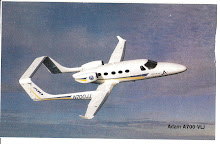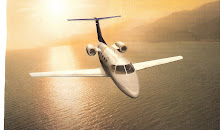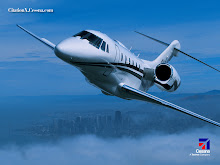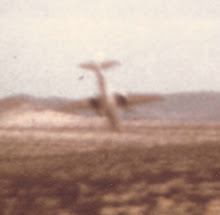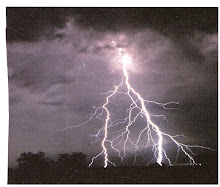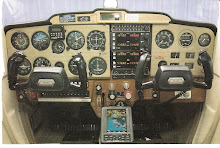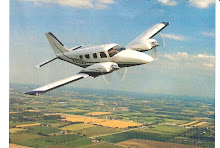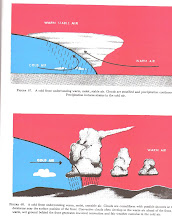Hi Readers: In flying, our radio and radar communications are all-important - a necessity from the beginning - to get from one point to another - from departure to arrival safely. This includes our use of radar navigation en route - some a convenience, others a necessity.
These radio and radar communications originate from a broad spectrum of frequencies (electromagnetic waves) broadcast and received by Transmitters and Receivers from a Low frequency (100 Khz) through MF, HF, VHF, UHF, SHF, and to EHF (Extremely High Frequency at 100 Ghz). If you've forgotten, Kilo is one thousand, Mega is one million, Gigga is one billion - and, of course, "Hertz" is the ICAO designation for cycles/second. These frequencies in the U.S. are assigned by the Federal Communication Commission (FCC) in collaboration with the International Civil Aviation Organization (ICAO).
In the very beginning, whether a local or X-C flight, we must necessarily contact a Ground Control, a Tower, or FSS to get departure instructions, and by regulation we must use the assigned frequencies. Normally, Towers and FSS's are assigned VHF frequencies (118+ Mhz). These frequencies can be found for any airport designated by the FAA. Ground Control frequencies are also in the VHF range, 121.66 to 121.9 Mhz.
En Route, we should expect to communicate with VORs and VORTACs (108-118 Mhz); or use GPS on 1215-1240 Mhz; or ARTC as assigned, perhaps NDB on 190-535 Khz; or LORAN C at 100 Khz; Mode S radar at 1030, 1090 Mhz; TCAS at 9660-1215 Mhz; and ARSR at 1215-1400 Mhz.
On Descent and Approach we'll use ILS Localizer on 108-112 Mhs (VHF) and Glideslope on 328.6 - 335.4 (UHF). And then back to the Tower and Ground Control frequencies. All of these communication frequencies have to be known and used, as needed, by the pilot. The emergency frequency is still 121.5 Mhz.
UNICOM (No Tower or FSS) uses CTAF (Common Traffic Advisory Frequencies) of 122.7-123.0 Mhz. Other communications frequencies designated by the FCC are air-to-air and private airports on 122.750 and 122.850 Mhz; air-to-air GA Helicopter communications on 123.025 Mhz; and Aviation Instruction, Glider, and Hot-Air Balloon operations in the 123.300 Mhz range.
Other Airborne frequency assignmentss are Microwave Landing Systems (MLS) used by DOT, DOD, and NASA are 5000-5150 Mhz, with DME at 960-1215 Mhz; Airborne Weather Navigation Radar at 9300-9500 Mhz; Airborne Radar Altimeter at 4200-4400 Mhz; and Precision Approach Radar (PAR) used by the Military at 9000-9200 Mhz.
Large Ship Radar at 2900-3100 Mhz and above; Amateur Radio (HAM) at 1800 Khz to 250 Ghz, and Space Communications at 2290-2300 Mhz are of interest to many users.
Surface frequencies of interest, also, are AM Radio 535-1700 Khz; FM Radio 88-108 Mhz; Short Wave Radio 5.9-26.1 Mhz; CB Radio 29.96-27.41 Mhz; Television 54-88 Mhz and 174-220 Mhz, depending on the Channel; Cordless Telephones 40 to 50 Mhz; and Cell Phones at 824-849 Mhz.
As the need for air travel and the increase of airplanes in the airspace appear, the lack of available radio frequencies may become a stumbling block in operations as early as 2005. The demand for assigned frequencies is getting beyond the supply. A log-term digital plan seems to be the best option for the future.
Thanks for listening. R.S.
Friday, December 28, 2007
Radio and Radar Communications
Labels:
air travel,
airspace,
communications,
CTAF,
FCC,
FSS,
GPS,
ICAO,
localizer,
Radar,
Radio,
tower operations,
UNICOM
Saturday, December 15, 2007
November 2007 Aircraft accidents/Incidents
Hi Readers: There were 65 accidents and two incidents for November 2007 as reported by NTSB (No accidents were reported for 11-17, 11-19, 11-24, 11-26, 11-29, and 11-30). The 65 accidents and the two incidents occurred in the Continental U.S., and 3 accidents occurred in foreign countries. There were 26 fatal accidents accounting for 52 fatalities (the 3 foreign accidents accounted for 9 fatalities). Alaska squeezed by this time with one Cessna non-fatal accident, with 2 serious injuries - an instruction flight, striking trees on an approach during dark night conditions. One incident involved a Delta Air Lines B-737 sustaining minor damage when the tire tread on the right outboard wheel separated and struck the airplane during takeoff from Phoenix Sky Harbor airport. The other, a UPS Douglas DC-8, experienced smoke in the cockpit from the lavatory area.
There was one mid-air collision - a Cessna 182A and an American Champion7GCBC collided at 1,500 ft msl over commencement Bay, Tacoma, Wa., the C-182A severing the Champions vertical stabilizer from above, the Champion then losing directional control and crash landing in the Bay. The Cessna landed successfuly. A taxiway collision occurred when a Cessna 208B collided with a Beech 18S at Opa LOcka, Fl. Both, cargo flights were taxiing to a refueling farm, neither pilot seeing the other airplane.
There were 5 non-injury and one fatal Helicopter accidents - a Bell 206A hard landing on a post-annual flight check, a Bell 222 when a wind gust forced the main rotor blade into the left vertical stabilizer fin and tail boom during engine start, a Hiller UH-12E involving inflight separation of a control rotor during an aerial application flight, a Robinson 22B touchdown in a left yaw during an instruction flight, and a Roloway Exec 162F impacted terrain in an emergency following a high frequency vibration in the main rotor blades. All incurred substantial damage. The fatal accident occurred when a Hughes 269C impacted the terrain, killing the pilot.
Once again the fatal accidents fuel the safety bin, indicating what we'll have to work on to prevent aircraft accidents. Taking the foreign accidents first, a Brazilian Learjet 35A crashed in a residential area of Sao Paula after takeoff, in daylight, incurring fatal injuries to the crew and 6 individuals on the ground, as well as 2 injuries on the ground. A French registered Piper PA-32R impacted terrain in daylight, under unknown circumstances, killing the pilot. A registered Mexican Cessna 208B experienced a forced landing following a loss of power on climbout. The Commercial pilot and two passengers were seriously injured, while 12 others sustained minor injuries.
There were 9 accidents involving the Cessna aircraft. An airline transport pilot departed Redding, Ca. on a day business x-c flight in a Cessna 340, 55 minutes later seen climbing out of a fog layer, heading into rapidly rising terrain at full power, clipping the tops of trees and impacting terrain. The pilot and two passengers recived fatal injuries. A Civil Air Patrol Cessna T182T was destroyed when impacting mountainous terrain at 7,200 ft msl below Mt. Potosi (8,514 ft msl) 24 miles SW of Las Vegas on a x-c flight to Rosamond, Ca. Both air transport pilots were fatally injured. VFR dark night conditions prevailed. A Cessna T210, on a night x-c flight, struck power lines on approach to R/W 19R to Jones airport near Tulsa, Ok. The weather was VFR, and an electrical problem was indicated. The pilot received serious injury, and the two passengers were fatal.
On a local instructional flight in VFR conditions, an instructor and student flying a Cessna 172N impacted terrain inverted, 90 degrees nose-down - witnesses indicated a possible engine problem. Injuries were fatal to both. A witness reported seeing a Cessna 177 impact the ground in a nose-down attitude near Auburn, CA. in daylight VFR conditions. The aircraft had been rented from an aviation club. The pilot and the passenger were fatally injured. Another impact with terrain was reported - a Cessna A150K loss of control during initial takeoff from R/W 35 at Mesquite airport in Texas - a local day flight. The pilot, an IP, and a passenger received fatal injuries. A witness saw the airplane enter a spin following folowing a nose-low steep turn. Another Cessna 172, piloted by a private certificated pilot, impacted terrain near Gladinar, Michigan, in day VFR conditions. The airplane was seen maneuvering at low altitude and descending nose-down into trees. And yet another Cessna 182Q was destroyed when it impacted trees and terrain while maneuvering on a pipeline patrol flight, in daylight conditions, near Farmerville, Louisiana - the pilot was killed. A 2-serious injury accident was reported near Palmer, Alaska, when an Instructor and student in a Cessna 150 struck trees on the approach to R/W 34 during dark night conditions. The 9 fatal Cessna accidents, primarily loss of control and/or critical judgment factors appear as a result of multiple causes. We'll await the final determinations made by NTSB for these accidents.
There were 3 Amateur-built fatal aircraft accidents during the period, one a Vans RV-10 aircraft, one a Herink Challenger II, and one a Blondin 601 HDS. All three impacted terrain in day VFR weather conditions. Another experimental home-built airplane, a Kewlly FID, crashed in a flat spin near Reno, Nevada, in daylight VFR conditions. The Commercial pilot sustained fatal injuries. And another experimental light sport airplane, operating under a special airworthiness certificate, a Zodiac 601 XC, collided with terrain near La Rille, Missouri. The airplane was seen rolling into a vertical descent following a left turn.
There was one Amateur-built helium balloon, a Padelt PG 37-1, that collided with power lines in Hampton, Iowa. The Commercial pilot and one passenger were fatally injured. The surviving passenger reported that a gust of wind pushed the balloon into a high tension power line. This, of course, is the principal hazard of the sport of balloon flying - you go where the wind blows and try to avoid the gusts.
The amateur-built aircraft accidents indicated low-time pilots, and some erratic flying at low altitude in VFR weather conditions. The amateur-experimental type aircraft requires a specific and special airworthiness certificate under FAR 21.191 (g), which includes air racing, kit-built aircraft, and light sport aircraft. The special airworthiness certificate, a study in itself, applies to the less complicated flying, but yet not without hazards. The experimental, amateur-built, and sport flying seems to be on the increase, and should be viewed in the same safety light as all other flying.
The subject of Airworthiness, very important, is simply aircraft being fit for flight, and will be discussed in detail at a later date.
Thanks for listening. R.S.
There was one mid-air collision - a Cessna 182A and an American Champion7GCBC collided at 1,500 ft msl over commencement Bay, Tacoma, Wa., the C-182A severing the Champions vertical stabilizer from above, the Champion then losing directional control and crash landing in the Bay. The Cessna landed successfuly. A taxiway collision occurred when a Cessna 208B collided with a Beech 18S at Opa LOcka, Fl. Both, cargo flights were taxiing to a refueling farm, neither pilot seeing the other airplane.
There were 5 non-injury and one fatal Helicopter accidents - a Bell 206A hard landing on a post-annual flight check, a Bell 222 when a wind gust forced the main rotor blade into the left vertical stabilizer fin and tail boom during engine start, a Hiller UH-12E involving inflight separation of a control rotor during an aerial application flight, a Robinson 22B touchdown in a left yaw during an instruction flight, and a Roloway Exec 162F impacted terrain in an emergency following a high frequency vibration in the main rotor blades. All incurred substantial damage. The fatal accident occurred when a Hughes 269C impacted the terrain, killing the pilot.
Once again the fatal accidents fuel the safety bin, indicating what we'll have to work on to prevent aircraft accidents. Taking the foreign accidents first, a Brazilian Learjet 35A crashed in a residential area of Sao Paula after takeoff, in daylight, incurring fatal injuries to the crew and 6 individuals on the ground, as well as 2 injuries on the ground. A French registered Piper PA-32R impacted terrain in daylight, under unknown circumstances, killing the pilot. A registered Mexican Cessna 208B experienced a forced landing following a loss of power on climbout. The Commercial pilot and two passengers were seriously injured, while 12 others sustained minor injuries.
There were 9 accidents involving the Cessna aircraft. An airline transport pilot departed Redding, Ca. on a day business x-c flight in a Cessna 340, 55 minutes later seen climbing out of a fog layer, heading into rapidly rising terrain at full power, clipping the tops of trees and impacting terrain. The pilot and two passengers recived fatal injuries. A Civil Air Patrol Cessna T182T was destroyed when impacting mountainous terrain at 7,200 ft msl below Mt. Potosi (8,514 ft msl) 24 miles SW of Las Vegas on a x-c flight to Rosamond, Ca. Both air transport pilots were fatally injured. VFR dark night conditions prevailed. A Cessna T210, on a night x-c flight, struck power lines on approach to R/W 19R to Jones airport near Tulsa, Ok. The weather was VFR, and an electrical problem was indicated. The pilot received serious injury, and the two passengers were fatal.
On a local instructional flight in VFR conditions, an instructor and student flying a Cessna 172N impacted terrain inverted, 90 degrees nose-down - witnesses indicated a possible engine problem. Injuries were fatal to both. A witness reported seeing a Cessna 177 impact the ground in a nose-down attitude near Auburn, CA. in daylight VFR conditions. The aircraft had been rented from an aviation club. The pilot and the passenger were fatally injured. Another impact with terrain was reported - a Cessna A150K loss of control during initial takeoff from R/W 35 at Mesquite airport in Texas - a local day flight. The pilot, an IP, and a passenger received fatal injuries. A witness saw the airplane enter a spin following folowing a nose-low steep turn. Another Cessna 172, piloted by a private certificated pilot, impacted terrain near Gladinar, Michigan, in day VFR conditions. The airplane was seen maneuvering at low altitude and descending nose-down into trees. And yet another Cessna 182Q was destroyed when it impacted trees and terrain while maneuvering on a pipeline patrol flight, in daylight conditions, near Farmerville, Louisiana - the pilot was killed. A 2-serious injury accident was reported near Palmer, Alaska, when an Instructor and student in a Cessna 150 struck trees on the approach to R/W 34 during dark night conditions. The 9 fatal Cessna accidents, primarily loss of control and/or critical judgment factors appear as a result of multiple causes. We'll await the final determinations made by NTSB for these accidents.
There were 3 Amateur-built fatal aircraft accidents during the period, one a Vans RV-10 aircraft, one a Herink Challenger II, and one a Blondin 601 HDS. All three impacted terrain in day VFR weather conditions. Another experimental home-built airplane, a Kewlly FID, crashed in a flat spin near Reno, Nevada, in daylight VFR conditions. The Commercial pilot sustained fatal injuries. And another experimental light sport airplane, operating under a special airworthiness certificate, a Zodiac 601 XC, collided with terrain near La Rille, Missouri. The airplane was seen rolling into a vertical descent following a left turn.
There was one Amateur-built helium balloon, a Padelt PG 37-1, that collided with power lines in Hampton, Iowa. The Commercial pilot and one passenger were fatally injured. The surviving passenger reported that a gust of wind pushed the balloon into a high tension power line. This, of course, is the principal hazard of the sport of balloon flying - you go where the wind blows and try to avoid the gusts.
The amateur-built aircraft accidents indicated low-time pilots, and some erratic flying at low altitude in VFR weather conditions. The amateur-experimental type aircraft requires a specific and special airworthiness certificate under FAR 21.191 (g), which includes air racing, kit-built aircraft, and light sport aircraft. The special airworthiness certificate, a study in itself, applies to the less complicated flying, but yet not without hazards. The experimental, amateur-built, and sport flying seems to be on the increase, and should be viewed in the same safety light as all other flying.
The subject of Airworthiness, very important, is simply aircraft being fit for flight, and will be discussed in detail at a later date.
Thanks for listening. R.S.
Saturday, December 8, 2007
The Need For Pilots and Technicians
Hi Readers: Having just read the January 2008 issue of Plane and Pilot (a GA - piston engine aircraft magazine), I,m happy to see some focus on the present low numbers of student pilots, pilots in general, and technicians. The articles by Peter Bunce of GAMA, and Marc C. Lee regarding the shortages and what can be done to reinvigorate GA interest was interesting, but barely scratching the surface for the root reasons. And, of course, the bulk of the shortages of pilots involve propjet and turbine jet pilots for the airlines and commuter flying.
In perspective, the shortages are not just GA, but well across the spectrum of aviation. Air travel is bursting at the seams, new types of airplanes, particularly jet types, are now being produced in numbers ---and where are the numbers of pilots, mechanics, and technicians to accommodate these increases?
Let's review the facts as seen by FAA: The total pilot population, now little greater than 598,000, will increase to about 722,000 by year 2030, an average growth over a 23-year period of 0.8%. The largest growth is expected in the Commercial and Student Pilot categories. Commercial aircraft operations (the sum of Air Carrier and Commuter/Air Taxi) at all U.S. airports (Towered and nontowered) are projected to increase from 29 million to 37.3 million in year 2020 and to 45.4 million in year 2030.
Meanwhile GA operations is forecasted to increase from about 81 million to 92.1 million in year 2020 and 100.4 million in year 2030. Much of the growth will be the result of increased use of a turbine fleet for Business/Corporate related flying. The Cargo jet fleet will have similar proportionate increases, and the Regional/Commuter fleet is expected to grow from about 2,800 aircraft to just under 5,000 by year 2030. By itself, GA aircraft is expected to increase from 227,000 to 275,000 in 2020, such growth because of flight-hour increases at a faster rate than the total aircraft fleet, but at the same time more sensitive to fuel prices and to variations in the general economic growth.
As for renewed interest by the younger populations in flying as pilots and other aviation careers, a study in itself, specific programs and efforts by Government, Aircraft Companies, and Training Schools must be designed and sponsored. I advocate a Govt-Industry sponsored Civilian Pilot and Technician Training Program (which I am currently working on), perhaps with service commitments to Military and Government Departments, to eliminate shortages and prepare for the future. Such a program was put in place by the Commerce Department in the 1930's, if you remember. In fact, I learned to fly in that very program, and was committed to service in the Army Air Forces.
The most plausible answer to the lack of interest and response to current aviation by the younger people, I think, is their lack of technical education, and the money, to pursue aviation pursuits and careers. Added to the problem is the seemingly lack of instructor people in the flying and technical aspects of the problem.
I'm still working on the November 2007 aircraft accident count and analysis.
To get away from some of our problems, I have a Cat story for you. I received the following in an early Christmas card from a friend in Monterey, California: (You don't have to own a cat to appreciate this one...)
A couple was dressed and ready to go out for the evening. They turned on a night light, turned on the telephone answering machine, covered their pet parakeet, and put the cat in the back yard. Then they phoned the local cab company and requested a taxi. The taxi arrived and the couple opened the front door to leave their house. The cat they had put out into the yard scoots back into the house. They don't want the cat shut in the house because "she" always tries to eat the bird. The wife goes out to the taxi while the husband goes inside to get the cat. The cat runs upstairs, the man in hot pursuit. The wife doesn't want the driver to know the house will be empty. She explains to the taxi driver that her husband will be out soon. "He's just going upstairs to say goodbye to my mother." A few minutes later, the husband gets into the cab. "Sorry I took so long," he says, as they drive away. "Stupid bitch was hiding under the bed. Had to poke her with a coat hangar to get her to come out! Then I had to wrap her in a blanket to keep her from scratching me. But it worked. I hauled her fat ass downstairs and threw her out into the back yard!" The cabdriver hit a parked car...
Thanks for listening. Robert Shaw.
In perspective, the shortages are not just GA, but well across the spectrum of aviation. Air travel is bursting at the seams, new types of airplanes, particularly jet types, are now being produced in numbers ---and where are the numbers of pilots, mechanics, and technicians to accommodate these increases?
Let's review the facts as seen by FAA: The total pilot population, now little greater than 598,000, will increase to about 722,000 by year 2030, an average growth over a 23-year period of 0.8%. The largest growth is expected in the Commercial and Student Pilot categories. Commercial aircraft operations (the sum of Air Carrier and Commuter/Air Taxi) at all U.S. airports (Towered and nontowered) are projected to increase from 29 million to 37.3 million in year 2020 and to 45.4 million in year 2030.
Meanwhile GA operations is forecasted to increase from about 81 million to 92.1 million in year 2020 and 100.4 million in year 2030. Much of the growth will be the result of increased use of a turbine fleet for Business/Corporate related flying. The Cargo jet fleet will have similar proportionate increases, and the Regional/Commuter fleet is expected to grow from about 2,800 aircraft to just under 5,000 by year 2030. By itself, GA aircraft is expected to increase from 227,000 to 275,000 in 2020, such growth because of flight-hour increases at a faster rate than the total aircraft fleet, but at the same time more sensitive to fuel prices and to variations in the general economic growth.
As for renewed interest by the younger populations in flying as pilots and other aviation careers, a study in itself, specific programs and efforts by Government, Aircraft Companies, and Training Schools must be designed and sponsored. I advocate a Govt-Industry sponsored Civilian Pilot and Technician Training Program (which I am currently working on), perhaps with service commitments to Military and Government Departments, to eliminate shortages and prepare for the future. Such a program was put in place by the Commerce Department in the 1930's, if you remember. In fact, I learned to fly in that very program, and was committed to service in the Army Air Forces.
The most plausible answer to the lack of interest and response to current aviation by the younger people, I think, is their lack of technical education, and the money, to pursue aviation pursuits and careers. Added to the problem is the seemingly lack of instructor people in the flying and technical aspects of the problem.
I'm still working on the November 2007 aircraft accident count and analysis.
To get away from some of our problems, I have a Cat story for you. I received the following in an early Christmas card from a friend in Monterey, California: (You don't have to own a cat to appreciate this one...)
A couple was dressed and ready to go out for the evening. They turned on a night light, turned on the telephone answering machine, covered their pet parakeet, and put the cat in the back yard. Then they phoned the local cab company and requested a taxi. The taxi arrived and the couple opened the front door to leave their house. The cat they had put out into the yard scoots back into the house. They don't want the cat shut in the house because "she" always tries to eat the bird. The wife goes out to the taxi while the husband goes inside to get the cat. The cat runs upstairs, the man in hot pursuit. The wife doesn't want the driver to know the house will be empty. She explains to the taxi driver that her husband will be out soon. "He's just going upstairs to say goodbye to my mother." A few minutes later, the husband gets into the cab. "Sorry I took so long," he says, as they drive away. "Stupid bitch was hiding under the bed. Had to poke her with a coat hangar to get her to come out! Then I had to wrap her in a blanket to keep her from scratching me. But it worked. I hauled her fat ass downstairs and threw her out into the back yard!" The cabdriver hit a parked car...
Thanks for listening. Robert Shaw.
Labels:
accidents,
air travel,
Airline pilots,
airlines,
Aviation careers,
cargo,
flying hours,
forecasts
Subscribe to:
Posts (Atom)

